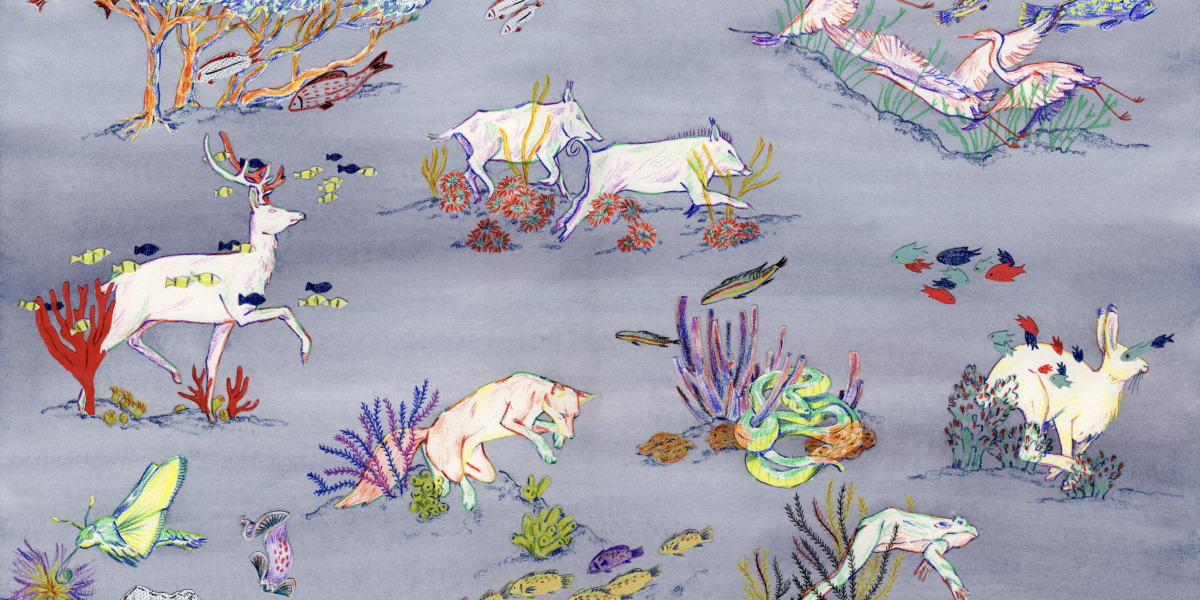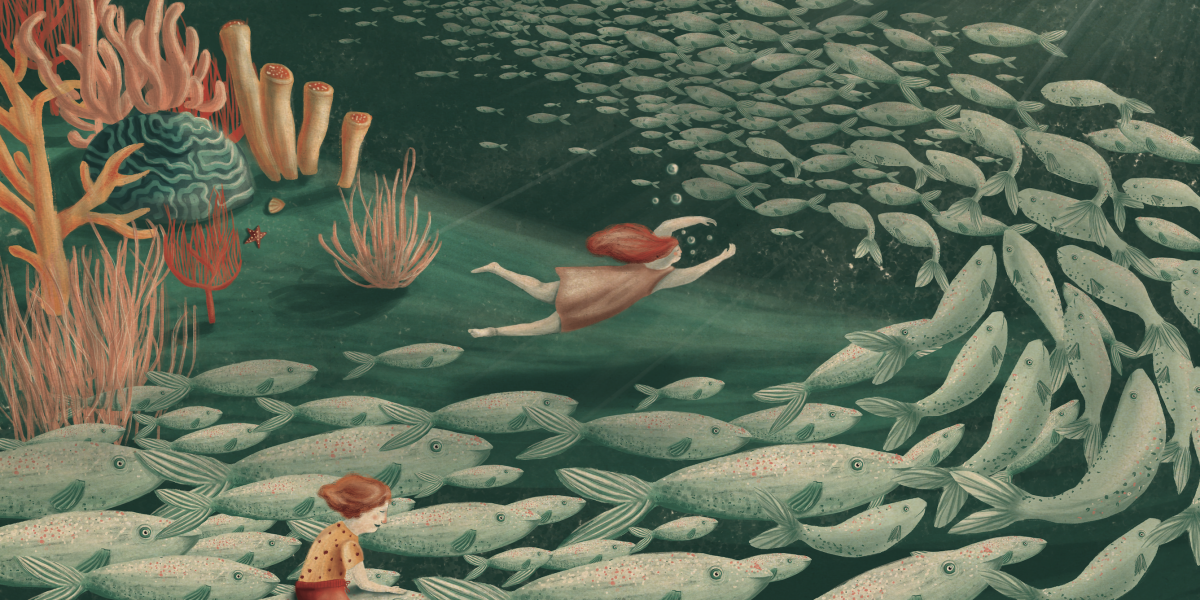
It is an Art&Science exhibition that aims to promote knowledge of the Sea through the storytelling and representation of the 7 principles of “Ocean Education.”

It is a major dissemination action promoted by the United Nations worldwide with the aim of spreading, at every level of civil society, knowledge about the Ocean and the interdependent relationship that binds us to the “big blue,” in order to protect it, conserve it, study it and use it sustainably.
In Ocean Literacy, we talk about scientific research and technological innovation but also about well-being, coexistence, respect and sustainability, bringing together topics that pertain to a wide range of disciplines, from science to the social sciences and artistic expression, making Ocean Literacy the largest multidisciplinary dissemination action on the Sea in the world.
To facilitate the understanding of such a vast and important topic, UNESCO’s Intergovernmental Oceanographic Commission (IOC-UNESCO) has developed seven principles, closely interconnected with each other, and capable, as a whole, of representing and expressing the importance of the role of the Oceans in the life of our planet, how close the interdependent relationships are between us and the Sea, and the need to act for its protection and sustainable use.
The protagonists of the widespread exhibition “The Sea is made in 7” are professional illustrators who, after a short training course held by researchers from OGS, AMP Mira- mare and EMSEA, have interpreted the 7 principles with their representational style and creativity, contributing to compose a unique narrative path about the Sea and the rap- port that binds us to it.

In school, as children, we learned the names of the world’s Oceans, but the truth is that there is only one Ocean, and if we look at the planisphere, this mass of water that seamlessly envelops the landmasses appears to us in all its prominence and vastness. The Ocean covers more than 70 percent of the Earth’s surface and comprises 97 percent of the volume of water on our planet.
These water masses are not static: winds, tides, sunshine, and ter- restrial rotation originate a circulation system that helps transport nutrient ele- ments from the surface to the depths and transfer heat from tropical to northern areas.
The Ocean is also an integral part of the water cycle and is connected through rivers and streams to all of Earth’s water supplies.
Ocean and Earth are also linked in the oceanic depths, on whose bottoms run ridges that communicate directly with the innermost parts of our planet.
Although immense, the Ocean is a finite system, and finite are also its resources, which are gradually diminishing.
These water masses are not static: winds, tides, sunshine, and ter- restrial rotation originate a circulation system that helps transport nutrient ele- ments from the surface to the depths and transfer heat from tropical to northern areas.
The Ocean is also an integral part of the water cycle and is connected through rivers and streams to all of Earth’s water supplies.
Ocean and Earth are also linked in the oceanic depths, on whose bottoms run ridges that communicate directly with the innermost parts of our planet.
Although immense, the Ocean is a finite system, and finite are also its resources, which are gradually diminishing.
Weather is what we see outside the window every day, while climate is the set of daily observations evaluated over a period of at least thirty years. And the Sea determines the characteristics of both one and the other.
Imagine it as the great engine of the weather system, capable of absorbing the sun’s energy by transforming it into heat and redistributing it, thanks in part to the atmosphere, throughout the planet. Its evaporation in the tropical zone also accounts for most of the rainfall and precipitation that affects the Earth.
But the carbon cycle, which is essential for life, also depends on the ocean: through photosynthesis, algae, marine plants and phytoplankton remove carbon ani- dride from the atmosphere, transforming it into organic matter. Other or- ganisms, such as mollusks and crustaceans, fix carbon molecules during the processes of building their shells and exoskeletons, storing them on the ocean floor.
If the Earth is inhabited, it is thanks to the Sea.
The earliest life forms that developed on our planet originated from the hydrothermal vents of the primordial Ocean floor: from there, life took on increasingly complex forms and arrived on land as well.
Even the emergence of oxygen, to which we owe life as we know it today and our existence on this planet, is a gift from the Ocean: oxygen was formed through photosynthesis by marine planktonic organisms and began to be preheard in the atmosphere 2.4 billion years ago.
And if that were not enough, the Seas provide us with food, water, and other nutrients: without the Ocean, we certainly could not all feed ourselves.
From microscopic plankton to the blue whale, the Ocean is home to an extraordinary quan- tity and variety of organisms, animal and plant. A biodiversity greater than that of the landmasses, but also decidedly less known and studied.
Marine habitats are also very different from one another: they range from land- and sea-straddling environments such as the intertidal, which is subject to ma- rea excursions, to the pelagic environment where large swimmers dart from coral reefs to muddy and sandy bottoms to the deepest abysses.
Each environment has very different chemical and physical characteristics-temperature, pH, salinity, oxygen and nutrients-that condition the presence of life and the development of the marine trophic network.
The Ocean influences our lives and we influence its life.
Every day the Sea provides us with oxygen, food, building materials, at- tive principles for our medicines, jobs, energy and economic resources. The Sea is, in addition, a source of well-being, inspiration and recreation.
However, the favors are not reciprocated. Despite all the services it renders us, we are impoverishing it: we destroy or alter habitats, we fish at a rate that exceeds the resource’s capacity to renew itself, we pollute it with waste and tos- sic substances, and we emit climate-change- ing gases that increase temperature and acidification, damaging biodiversity and its fragile balance. In doing so, we end up com- promising the very benefits on which our survival and well-being depend.
We should become more aware of our actions on the Ocean and learn to care for it to safeguard our own existence.
In contrast to landmasses, to date, barely one-fifth of the seafloor is mapped in high definition. We still know too little about what goes on in the Ocean, the life forms that inhabit its depths, and the physical and biochemical processes that regulate its balances. Some oceanic areas are still unknown despite the technologies and means of research available to us today. We know the surface of Mars better than the ocean floor!
Yet, knowing the Ocean, and knowing it well, is crucial for our Pia- neta and for our life on earth.
As the great oceanographer Sylvia Earle said, “The greatest threat to the Ocea- no is ignorance.” But it is also so for us, who depend on the Ocean.
The artists in the exhibition
Roberto Blefari
Gaia Cairo
Laura Galeazzo
Ilaria Paolucci
Irene Penazzi
Emanuela Alexandra Sandu
Marco Tabilio
Martina Tonello
Curator
Lorenzo Peter Castelletto – AMP Miramare
© 2020 WWF AMP Miramare | All rights reserved